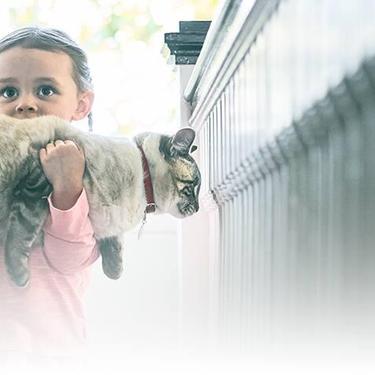
-
Find the right food for your petTake this quiz to see which food may be the best for your furry friend.Find the right food for your petTake this quiz to see which food may be the best for your furry friend.Health CategoryFeatured products
 Adult Large Breed Chicken & Barley Recipe Dog Food
Adult Large Breed Chicken & Barley Recipe Dog FoodSupports healthy joints, lean muscle, and beautiful coat for large breed dogs
Shop Now Hill's Science Diet Adult Healthy Mobility Large Breed Chicken Meal, Barley & Brown Rice Recipe Dog Food
Hill's Science Diet Adult Healthy Mobility Large Breed Chicken Meal, Barley & Brown Rice Recipe Dog FoodAdvanced nutrition shown to support joint health and improve mobility
Shop Now Adult Light Large Breed Chicken Meal & Barley Recipe Dog Food
Adult Light Large Breed Chicken Meal & Barley Recipe Dog FoodFewer calories for less active large breed dogs
Shop NowFeatured products Adult Oral Care Chicken & Brown Rice Recipe Cat Food
Adult Oral Care Chicken & Brown Rice Recipe Cat FoodClinically proven kibble technology to reduce plaque & tartar build-up
Shop Now Adult Perfect Digestion Chicken, Barley & Whole Oats Recipe Cat Food
Adult Perfect Digestion Chicken, Barley & Whole Oats Recipe Cat FoodHill's Science Diet's breakthrough nutrition supports ultimate digestive well-being & healthy microbiome
Shop Now Adult Sensitive Stomach & Skin Pouch Variety 12 Pack Cat Food, Chicken & Beef, Salmon & Tuna
Adult Sensitive Stomach & Skin Pouch Variety 12 Pack Cat Food, Chicken & Beef, Salmon & TunaCarefully made, gourmet daily nutrition. Tasty chunks with Salmon & Tuna in a decadent gravy. Supports digestive health, nourishes skin and promotes a lustrous fur.
Shop Now -
DogCat
- Cat Tips & Articles
-
Health Category
- Weight
- Skin & Food Sensitivities
- Urinary
- Digestive
- Kidney
- Dental
- Serious Illness
-
Life Stage
- Kitten Nutrition
- Adult Nutrition
Featured articles Cat vs. Dog: Which Is the Best Pet for Me?
Cat vs. Dog: Which Is the Best Pet for Me?Learn about important differences between dogs and cats, such as cost & space considerations. These factors can help you decide which pet is best for you.
Read More Adopting a Pet: What You Need to Know
Adopting a Pet: What You Need to KnowLearn the basics of adopting a pet, including where to begin and common questions you should ask yourself when deciding which kind of pet is best for you.
Read More Fun Ideas for Kids and Pets This Summer
Fun Ideas for Kids and Pets This SummerOutdoor summer activities with your dog or cat can be fun for kids, too. Learn how they also teach kids responsibility & creates a bond with their pet.
Read More -


Too often, pet owners resort to punishment when they believe a pet has stepped out of line. Punishment is a poor tool for shaping behavior in most situations. Physical corrections and harsh scolding are likely to bruise your relationship and can lead to more serious problems, such as aggression.
 Never hit, shake or yell at your kitten. If you need to interrupt a behavior, such as scratching furniture, use a spray bottle or make a sharp noise by tapping a tabletop or clapping your hands loudly. Avoid doing anything that makes your kitten act frightened or reluctant to approach you.
Never hit, shake or yell at your kitten. If you need to interrupt a behavior, such as scratching furniture, use a spray bottle or make a sharp noise by tapping a tabletop or clapping your hands loudly. Avoid doing anything that makes your kitten act frightened or reluctant to approach you.
Understanding your kitten's body language
Cats are good at letting you know what they want, either vocally or with their bodies. It won't be long before you understand what your kitten is trying to tell you.
Meows
As your kitten grows up, you start to hear distinctive "meows" from her. Low-pitched meows usually mean your cat is uncomfortable or unhappy. High-pitched meows mean she's happier, and if she keeps repeating them, she's wanting your attention. Maybe she feels it’s time for her favorite kitten food? With a little practice, you'll soon get to know what your kitten's trying to say.
Interestingly, meows are hardly ever directed at other cats, nearly always at humans. So listen up, she's talking to you. Learn more about a cat’s meow.
Purring
Purring is usually a sign of contentment, although it doesn't always indicate happiness. A cat that is ill or anxious will sometimes purr as a comfort. However, most of the time if your kitten is rubbing against you and purring loudly, it's a sign of affection or she's asking for something, such as food.


Tasty Tips
Hisses and growls
If you're hearing these, you've got one frightened little kitten. She's trying to puff herself up to sound scary so she can protect herself. You'll usually hear her hiss and growl during tense encounters with other animals.
Rubbing
When your kitten rubs her face up against you, it means she's really comfortable in your company and is showing she likes you.
Rolling over
If your kitten rolls over onto her back and stretches her legs, she is indicating complete submissiveness and trust in you. She's also asking for attention. And when she hops onto your lap and snuggles down contentedly, there's no doubt how she views her new environment.
Tell-tail
A cat's tail is an excellent indicator of her feelings. A happy kitten will hold her tail straight up; if she's frightened, she'll tuck it between her legs. The broad swishing, of an adult cat's tail shows annoyance or impatience. If she's really agitated, her tail will move rapidly from side to side — this is clearly threatening behavior. A twitching tail is a sure sign of your kitten's excitement and curiosity. Learn more about the cat’s tail.
Ears
Pricked ears are an indication of interest in what's going on around her as well. Ears held erect and inclined forward, she's relaxed and friendly. But when a cat's ears go down, flat against her head, it's a sign of aggression; this is done to keep them out of the way should a fight erupt.


One of our staff authors prepared this article for you
Related products

Clinically proven kibble technology to reduce plaque & tartar build-up

Carefully made, gourmet daily nutrition. Tasty chunks with Salmon & Tuna in a decadent gravy. Supports digestive health, nourishes skin and promotes a lustrous fur.

Delicious tender chicken and rice in a mouthwatering sauce with precisely balanced nutrition to support 5 essential building blocks for lifelong health

Hill's Science Diet's breakthrough nutrition supports ultimate digestive well-being & healthy microbiome
Related articles

Get helpful information on proper feline oral healthcare and why it's so vital to take care of your cat's teeth.

Understand the symptoms of a chronic upset stomach in your cat, and learn how to help sooth their discomfort.

Provide the best possible treatment for cats with sensitive skin by spotting the signs, knowing the causes, and understanding the remedies. Learn more now.

Obesity affects more than 30 percent of cats in America. Learn how you can properly feed and exercise your cat to improve its weight management.

Put your cat on a diet without them knowing
Our low calorie formula helps you control your cat's weight. It's packed with high-quality protein for building lean muscles, and made with purposeful ingredients for a flavorful, nutritious meal. Clinically proven antioxidants, Vitamin C+E, help promote a healthy immune system.
Put your cat on a diet without them knowing
Our low calorie formula helps you control your cat's weight. It's packed with high-quality protein for building lean muscles, and made with purposeful ingredients for a flavorful, nutritious meal. Clinically proven antioxidants, Vitamin C+E, help promote a healthy immune system.

